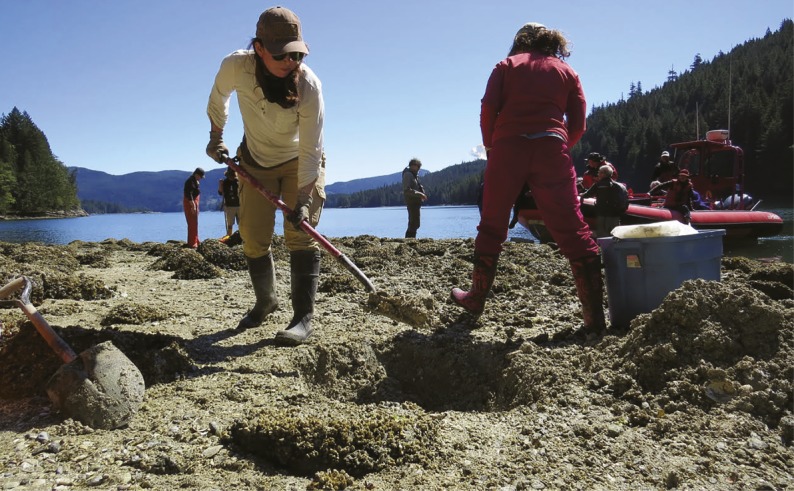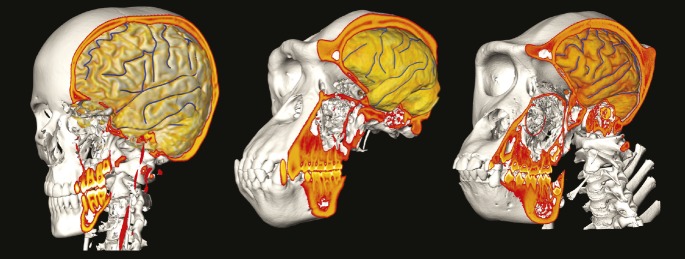Brain reorganization during human evolution
CT/MRI skull and brain imaging data of a human (Left), a chimpanzee (Center), and a gorilla (Right).
The human brain and braincase differ significantly from those of great apes in size and structure. Brain structures of fossil hominins are typically inferred from braincase structures, but the extent to which brain and braincase structure coevolved remains unclear. José Luis Alatorre Warren et al. (pp. 22115–22121) analyzed MRI and CT/MRI skull and brain imaging data for 41 humans, ages 4–74 years; 24 chimpanzees; and 2 gorillas. The authors quantified structural variation in brain surface and braincase morphology, both within and between species, based on the relative positions of cortical sulci and the sutures between cranial bones. The authors found moderate levels of covariation between brain and braincase features in both humans and chimpanzees. Compared with chimpanzees and gorillas, human brains exhibited distinct positions of brain sulci relative to cranial sutures and less overall covariation between brain and braincase features. The results suggest that brain and braincase structures evolved independently from each other. According to the authors, changes in braincase morphology observed in the fossil record might reflect constraints related to increased encephalization and evolution of obligate bipedalism, rather than changes in brain structure. — B.D.
Amazon deforestation and malaria transmission
Anthropogenic impacts on the environment can harm public health, but the majority of evidence linking the two is locally specific and dependent on ecological context, such as region or climate conditions. To determine whether malaria transmission in Brazil is influenced by deforestation in the Amazon, Andrew MacDonald and Erin Mordecai (pp. 22212–22218) compared a dataset of malaria cases reported in 795 municipalities of the Brazilian Amazon between 2003 and 2015 with annual forest loss and total forest cover from the Hansen Global Forest Change dataset. The authors found that a 10% increase in deforestation was correlated with a 3.27% increase in malaria cases. This effect was more apparent in the Amazon’s interior region than the outer Amazonian states, where comparatively little forest remains. Moreover, an approximate 1% increase in malaria cases was correlated with a 1.4% decrease in cleared forest area. An increase in malaria cases was also correlated with precipitation and optimal temperature for transmission in the dry season, when malaria is most frequently transmitted. The results suggest that deforestation increases the number of malaria cases, which in turn reduces forest clearing. This bidirectional feedback exemplifies how environmental and human health are intertwined, according to the authors. — M.S.
4D electron microscopy for T cell binding and activation
Photon-induced near-field electron microscopy, or PINEM, helps visualize nanoscale structures and interfaces by capturing exceedingly short-lived interactions between electrons and light-excited electromagnetic fields. Although recent work has demonstrated that incident radiation at specific wavelengths can induce cancer cells to emit a weak but detectable PINEM signal, the cellular properties that produced the response have not been determined. Yue Lu, Byung-Kuk Yoo, et al. (pp. 22014–22019) report that PINEM can detect human T lymphocyte activation and that the activation, in turn, reveals details about cellular physical properties that shape the PINEM signal. The authors demonstrate that T cell receptors (TCRs) in unstimulated T cells predominate the PINEM signal, to the extent that TCR binding spatially reorganizes the cell surface and attenuates the signal. Furthermore, the findings indicate that such attenuation can occur after TCR binding, even if the T cell remains inactivated. The authors also report that the technique can detect small changes in PINEM intensity that are associated with nanoscale features of biological surfaces and interfaces. Hence, the technique may represent a highly sensitive, label-free approach to probe cell surface features at scale. Although further investigation is needed, the study represents proof of concept for PINEM as a biological imaging tool, according to the authors. — T.J.
History of clam cultivation

Archaeologists excavating a clam garden. Image courtesy of Keith Holmes (Hakai Institute, Heriot Bay, BC, Canada).
Tracking the relationship between humans and culturally and economically relevant species can inform ecological studies. In particular, ecological records of species cultivated by humans can show how traditional cultivation practices have affected the numbers and health of a species. Ginevra Toniello, Dana Lepofsky, et al. (pp. 22106–22114) studied the growth of butter clams in the northern Salish Sea in British Columbia, Canada, over the last 11,500 years by measuring the overall size and the width of growth rings of clam shells from 5 beach sites. Clam size and age at death increased following the end of the last glacial period, suggesting improved habitat conditions. Middens indicating human harvesting of clams date to around 9,000 years ago, and by around 3,500 years ago, people began constructing clam gardens as a form of aquaculture. Traditional management practices meant that clam populations thrived during the aquaculture period, despite heavy harvesting pressure. According to the authors, traditional clam gardens were more productive than current untended clam beaches, suggesting that adopting traditional practices may help increase productivity of farmed marine species and maintain healthy ecosystems. — P.G.
Predicting adverse events induced by immune checkpoint therapy
The antitumor activity of immune checkpoint therapy can produce substantial clinical benefits in cancer patients. However, treatment can result in life-threatening immune-related adverse events, including inflammation of the pituitary gland and lung tissues. Salahaldin Tahir, Jianjun Gao, Yuji Miura, et al. (pp. 22246–22251) report that autoantibodies in peripheral blood hold potential as biomarkers for inflammation induced by immune checkpoint therapy. When comparing pretreatment and posttreatment blood samples, the authors found a higher increase in levels of autoantibodies against the molecules G(olf) subunit alpha (GNAL) and integral membrane protein 2B (ITM2B) in a group of 3 patients with pituitary inflammation, compared with a group of 6 patients without this condition. In a confirmation cohort, both pretreatment and posttreatment blood samples had higher levels of autoantibody against GNAL in a group of 5 patients with pituitary inflammation, compared with a group of 15 individuals without this condition. Similarly, levels of autoantibody against the CD74 protein were significantly higher in both pretreatment and posttreatment blood samples in a group of 10 patients with lung inflammation, compared with a group of 22 individuals without this condition. According to the authors, the findings suggest that anti-GNAL, anti-ITM2B, and anti-CD74 autoantibodies could serve as predictive or treatment biomarkers for the early detection, close monitoring, and timely treatment of pituitary and lung inflammation resulting from immune checkpoint therapy. — J.W.
Yolk protein transport in viviparous fish
The embryo develops inside mothers in viviparous animals and inside eggs in oviparous animals. The yolk protein vitellogenin, which is conserved in nearly all oviparous species, has been genetically lost in viviparous mammals but is conserved in some viviparous fish species. Atsuo Iida et al. (pp. 22359–22365) report that vitellogenin proteins produced in the maternal liver are nutrients that are transferred to the embryo in the viviparous bony fish Xenotoca eiseni. In pregnant fish, the authors detected the presence of vitellogenin proteins in the liver and ovary, which carries the embryo in this species. In addition, the authors detected vitellogenin proteins or protein fragments in a pseudoplacenta called the trophotaeniae and in the ovary and ovarian fluid. After injecting fluorescently labeled vitellogenin protein into the abdominal cavity of a pregnant fish, the authors found that the protein had been transferred to the digestive tract of the embryo via the trophotaeniae. According to the authors, the findings suggest that vitellogenin proteins function as nutrients transferred from the mother to the embryo in some viviparous species. — J.W.



